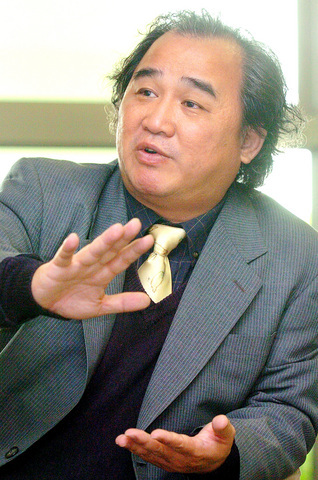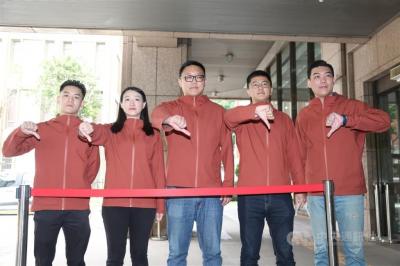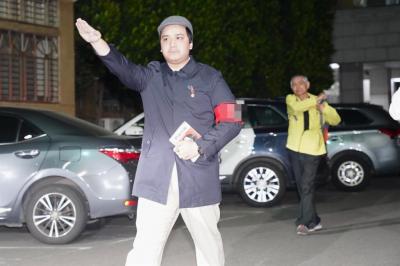Taipei Times: Recently, the Council for Cultural Affairs has tried to forge a "movement of cultural citizenship." Can you briefly talk about this "cultural citizenship" and how it relates to the creation of a Taiwanese identity?
Wu Ching-fa (吳錦發): To put is simply, "cultural citizenship" is the citizen's right to culture. It is comprised of two concepts: citizenship and cultural rights. As Taiwan's history progressed, culture was divided into two aspects -- high culture and popular culture. In the political climate of the past, popular culture was denigrated. Sung Chiang Battle Array and Taiwanese Opera, for instance, were considered "low-class" culture.
The intellectuals who created the refined "high culture" never ventured into the realm of popular culture to see what was behind it. For example, the U Theater Sacred Drumming troupe and the Cloud Gate performers used to think that only a venues such as national theaters were worthy of their performances. Lin Huai-min (林懷民), however, personally told me that when the Cloud Gate troupe performed in an open compound back in his hometown of Peikang for the town's elderly, no one left during the performance.

PHOTO: GEORGE TSORNG, TAIPEI TIMES
Lin said that there is nothing in the national theater scene that compares to the concentration and emotions displayed by this elderly audience.
Lin's experience contains a valuable lesson -- when we think that peasants or the general public cannot understand high culture, we are actually entrapped by a presupposition. Unfortunately, when this false presupposition is practiced for a long time, it becomes reality.
TT: Can you give us an example of how the general public can fully appreciate what intellectuals call "high culture"?
Wu: I have spent more than 10 years studying the folk arts of the Neiman Community in Kaohsiung. Among the folk arts in Neiman, the "Seven Sounds Array" (七里響) [a branch of traditional music called Nanguan, which consists of dancing, acting, spoken dialogue and sometimes acrobatics], has existed in the village for more than 400 years. Taking the "Seven Sounds Array" as an example, the content of traditional opera is the Tale of Li Wa originally from the Tang Dynasty, a drama which used to be a form of popular culture but is now considered high culture.
In the "Seven Sounds Array," performances sing a seven-word quatrain. Even though not every performer can recognize each word in the classical Chinese text, it seems that every performer can understand the script and his or her role in the performance. This is because they know the alluring story well. In the love story, a young man of letters squandered all his fortune on a fair, famed young singer in a brothel. Years later, when Li Wa no longer had to work there, she came cross the destitute boy on the street. Li Wa took him under her wing and the diligent youth eventually captured honors in the annual Imperial Examination.
Even students of Chinese literature may not be able to appreciate the Tale of Li Wa as well as those performers do. So, where is the boundary between high culture and popular culture? Popular culture and high culture are not mutually exclusive.
In retrospect, the dichotomy between the so called canonized works, such as articles by Tang essayist Han Yu (韓愈), and secular literature, such as The Romance of Three Kingdoms or Dream of Red Chambers is man-made, artificial, and changeable. Usually, it is secular literature that can still enchant common readers even after a thousand years.
Look at our society. Except for professors of Chinese literature, who still read essays by Han Yu? But hundreds of thousands are still influenced by The Romance of Three Kingdoms and Water Margin which are adapted into other forms of folk art. Secular literature is an invisible educational tool for the general public.
The impact of popular culture could be much broader across contemporary society and more profound for future generations. Maybe, academia nowadays churns out more theories and dissertations on Dream of Red Chambers than on Han Yu.
TT: In your view, what are the major consequences of the dichotomy between high culture and popular culture in Taiwanese society?
Wu: Taiwan's culture is cut into two. For the past few decades, the prejudice against popular culture has narrowed folk artists' access to sophisticated culture. On the other hand, creators of high culture have failed to absorb the essence of popular culture. The dichotomy is thus ever more entrenched over time.
This is the barrier we want to break down. This is why we initiated the "cultural citizenship" movement. If every citizen can enjoy equal political and economic rights, why can't they also enjoy equal cultural rights?
When the South Korean thinker Kim Young-oak [founder of the Korea Institute for Classical Studies in Seoul] visited Taiwan, he pointed out the problem of the dichotomy between high and popular culture. South Korea has had a similar experience. However, over the past 15 years, South Korea's Ministry of Culture and Tourism dedicated itself to promoting a folk art dance called "masque dance." Now the masque dance is staged during every international media spectacle in South Korea and has become a popular field of study in the universities. Foreigners who see the masque dance can immediately tell it is from South Korea.
Likewise, a glimpse at Taiwan's Aboriginal cultures demonstrated again how much has been left out under the rubric of high culture. Of all the countries I have seen in my lifetime, I have never seen a nation with as many diverse cultures as Taiwan. The Amis Ilisin (Harvest Festival) on the east coast, for instance, is a ritual that incorporates Amis people's traditional singing, dancing, faith in nature and philosophy.
From July to the end of August every year, the spirit of the Harvest Festival sweeps through every Amis village from Hualien all the way down to Taitung. Yet we seldom try to understand the cultural components of the Amis. Do we know why women hold a high place in Amis rites? Few people realize that the Amis' matriarchal society is founded on their belief systems. The Amis believe there are five life-bearing divinities in nature -- ocean, river, land, fruit tress and women. All these are sacred, inviolable and give new life.
The cultural differences are felt on both sides. When I went to see an ailing Amis chief, I was shocked by the lingering question the chief had on his death bed. He said he simply couldn't figure out why the offspring of Amis women with Han men have to assume their Han husbands' surnames.
The story of Lee Kuang-hui (李光輝) -- Taiwan's version of Robinson Crusoe -- is yet another example. As a young Amis boy, Lee was forced to serve in the Japanese military during World War II. Luckily, Lee managed to flee into the jungle on an Indonesian islet. After 30 years of solitary life in the jungle, Lee returned to Taiwan in 1975. He was confused by the ecstatic media coverage about him. "Why do they say that I have not returned home in 30 years? I come home so often!" he said to his Amis friends.
The journalists of course failed to understand the Amis' "Eagle Belief." The Amis people believe that when one is far from home, all they have to do it to watch an eagle circling in the sky, sit down, and pray to the eagle to take their soul home. Lee never thought that he was isolated from his Amis village.
Aboriginal people's philosophy of life has never been widely studied by anthropologists until very recently. There is an urgent need to collect and catalogue the essence of Taiwan's indigenous culture. We need to initiate exchanges between high culture and popular culture. Such cultural mobility is what the "cultural citizenship" movement aims to achieve.
TT: Apart from the high and low culture dichotomy, what are the other characteristics of Taiwanese culture? How does Taiwanese culture distinguish itself from Chinese culture -- from which many people think Taiwanese culture developed?
Wu: "Chinese culture" is a very nebulous concept. It depends on which area, which dynasty and which people you are talking about. For sure, the Chinese culture of the Tang Dynasty is very different from that of the Soong Dynasty or the Ming Dynasty.
The notion of "de-sinicization" may carry political significance, but is meaningless in the cultural sphere. What's important now is finding out how to create a unique culture and identity. One culture is often internalized into another culture. For instance, "Warrior Lanling" dance created in about 560 AD during the Wei Jin South and North Dynasties can barely be recognized in Beijing Opera. However, the "Warrior Lanling" has been handed down from generation to generation by Japan's Kyushu. I have seen Japanese villagers wear blood-red masks and mimic how Lanling fought his enemies under old banyans in green rice paddies. Villagers sung in Japanese.
Would you say "Warrior Lanling" is Chinese culture or Japanese culture? It has already become an integral part of Japanese culture.
A vestige of ancient and medieval Han culture is also rooted in Taiwan. Take the Sung Chiang Battle Array for example. The war dance is adapted from the Ming Dynasty General Qi Jiguang (
The father of President Chen Shui-bian (陳水扁), for instance, used to play the role of "soldier of rattan shield" in the Sung Chiang Battle Array. This is why when dancers of the array performed with nunchucks [which are not used in the traditional Sung Chiang Battle Array dance] in an attempt to please the president, Chen immediately saw through the ruse.
Now, when people see the Sung Chiang Battle Array, they recognize it as Taiwanese culture. It is undeniable that Taiwan has been influenced by parts of the Ming and Qing dynasties. Even now, the deceased in Neiman are still dressed in Ming costume before they are placed in their coffins.
TT: With the rise of Taiwanese self-awareness, the localization movement is growing. What are your thoughts on localization?
Wu: We can look at the concept of localization from an environmental perspective. Taiwan is rich in unique plant and animal species -- the Formosan rock macaques, Formosan black bears and the Formosan Koelreuteria are prime examples. There are two factors behind Taiwan's ecological diversity -- geological isolation and evolution. Taiwan, separated from China by the Taiwan Strait, has developed its own ecosystem that is dramatically different from the Chinese continent. High mountains, monsoons and ocean currents help create a unique, diverse ecosystem.
Ecological evolution also has its cultural equivalent in Taiwan. Han culture is a latecomer to Taiwan's history. Prior to the first migration of Han people to the island, Taiwan was a part of the Austronesian people. Before the Han people gained dominance, Taiwan's culture was ocean-oriented. Even nowadays, some Tao people on Orchid Island still think Taitung is further away than the Philippines.
Unfortunately, under a series of foreign colonial regimes, Taiwan lost its self-awareness. The people of Taiwan became too busy comparing Japanese colonial rule with that of the Chinese Nationalist Party (KMT) government, thereby losing their true cultural identity. Some identified with Japan's colonial regime, while others believed in the "greater China" lauded by the KMT.
One thing is clear -- we must condemn colonial regimes, but we do not turn our backs on the modernization colonial rule brought to Taiwan. Every legacy has two sides. Every story must be read through the lens of opposing sides. For example, over one-third of the Atayal language is Japanese in origin. The Japanese enriched the lexicon of the Atayal language. On the other hand, the Atayal people almost lost their cultural roots.
Diversity and chaos often go hand in hand. This is why we need to push for localization. We need to learn how to look inside Taiwan and find out what it truly is. Vivaciousness and resilience, I'd say, are the Taiwanese people's most valuable assets. If we pull out all the China-based Taiwanese businessmen, will Taiwan face an economic death? I don't think so. Taiwanese businessmen will go all over the globe and survive.
TT: What are your expectations for Taiwan? What kind of role do you think Taiwan will play in East Asia 10 or 20 years from now?
Wu: I am confident of Taiwan's future. The wheel of time will not stop moving forward because of any one person. It is the democratization of Taiwan that will leave Taiwan's footprint in world history. In East Asia, democracy in Japan was brought by the US. South Korea and Taiwan fought bloody battles to win democracy. The fight for democracy, in fact, is the way the Taiwanese people fought to realize themselves.
It is the process of fighting for democracy that Taiwan can offer insights into not only East Asia but also Communist China.

Taiwan is stepping up plans to create self-sufficient supply chains for combat drones and increase foreign orders from the US to counter China’s numerical superiority, a defense official said on Saturday. Commenting on condition of anonymity, the official said the nation’s armed forces are in agreement with US Admiral Samuel Paparo’s assessment that Taiwan’s military must be prepared to turn the nation’s waters into a “hellscape” for the Chinese People’s Liberation Army (PLA). Paparo, the commander of the US Indo-Pacific Command, reiterated the concept during a Congressional hearing in Washington on Wednesday. He first coined the term in a security conference last

Prosecutors today declined to say who was questioned regarding alleged forgery on petitions to recall Democratic Progressive Party (DPP) legislators, after Chinese-language media earlier reported that members of the Chinese Nationalist Party (KMT) Youth League were brought in for questioning. The Ministry of Justice Investigation Bureau confirmed that two people had been questioned, but did not disclose any further information about the ongoing investigation. KMT Youth League members Lee Hsiao-liang (李孝亮) and Liu Szu-yin (劉思吟) — who are leading the effort to recall DPP caucus chief executive Rosalia Wu (吳思瑤) and Legislator Wu Pei-yi (吳沛憶) — both posted on Facebook saying: “I

Sung Chien-liang (宋建樑), who led efforts to recall Democratic Progressive Party (DPP) Legislator Lee Kun-cheng (李坤城), was released on bail of NT$80,000 today amid outcry over his decision to wear a Nazi armband to questioning the night before. Sung arrived at the New Taipei District Prosecutors’ Office for questioning in a recall petition forgery case last night wearing a red armband bearing a swastika, carrying a copy of Adolf Hitler’s Mein Kampf and giving a Nazi salute. Sung left the building at 1:15am without the armband and covering the book with his coat. Lee said today that this is a serious

The Ministry of Economic Affairs has fined Taobao NT$1.2 million (US$36,912) for advertisements that exceed its approved business scope, requiring the Chinese e-commerce platform to make corrections in the first half of this year or its license may be revoked. Lawmakers have called for stricter enforcement of Chinese e-commerce platforms and measures to prevent China from laundering its goods through Taiwan in response to US President Donald Trump’s heavy tariffs on China. The Legislative Yuan’s Finance Committee met today to discuss policies to prevent China from dumping goods in Taiwan, inviting government agencies to report. Democratic Progressive Party Legislator Kuo Kuo-wen (郭國文) said